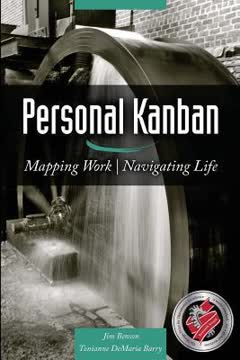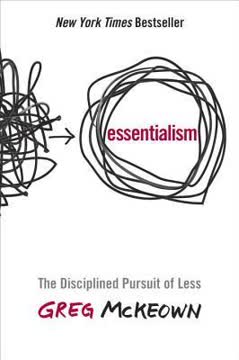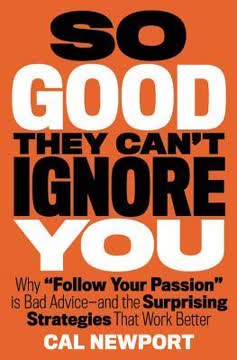Key Takeaways
1. The hyperactive hive mind workflow is reducing productivity in knowledge work
The office of 2021 is not the office of 1991 plus some extra capabilities; it's instead a different office altogether—one in which work unfolds as a never-ending, ad hoc, unstructured flow of messages, a workflow I named the hyperactive hive mind.
Constant context switching. The hyperactive hive mind workflow, characterized by constant email and instant messaging, severely impairs our ability to focus and produce quality work. Research shows that knowledge workers:
- Check email or instant messenger every 6 minutes on average
- Spend over 3 hours a day on email
- Take 23 minutes to refocus after an interruption
Cognitive costs. This constant task-switching comes with significant cognitive costs:
- Reduced ability to concentrate deeply on complex problems
- Increased mental fatigue and stress
- Lower overall productivity despite feeling "busy"
Inefficient communication. The hive mind approach often leads to:
- Drawn-out email threads that could be resolved quickly in person
- Misunderstandings due to lack of non-verbal cues
- Time wasted on low-value communication
2. Constant digital communication is making us miserable and anxious
To your entrenched social circuitry, evolved over millennia of food shortages mitigated through strategic alliances, these unanswered messages become the psychological equivalent of ignoring a tribe member who might later prove key to surviving the next drought.
Psychological toll. Our brains are not wired to handle the constant influx of messages and perceived social obligations:
- Increased stress and anxiety levels
- Feeling of always being "on call"
- Difficulty disconnecting from work
Work-life imbalance. The hive mind workflow blurs the lines between work and personal life:
- Checking email outside of work hours becomes normalized
- Vacations and downtime are interrupted by work communications
- Reduced ability to be present in personal relationships
Burnout risk. Prolonged exposure to this communication overload can lead to:
- Emotional exhaustion
- Reduced job satisfaction
- Higher turnover rates in organizations
3. Email emerged as a solution but created unintended consequences
Email isn't additive; it's ecological. The office of 2021 is not the office of 1991 plus some extra capabilities; it's instead a different office altogether—one in which work unfolds as a never-ending, ad hoc, unstructured flow of messages, a workflow I named the hyperactive hive mind.
Historical context. Email was initially adopted to solve real problems:
- Replaced inefficient communication methods (fax, memos)
- Enabled asynchronous communication across time zones
- Reduced the need for in-person meetings
Unintended effects. However, email's ease of use led to:
- Exponential growth in the volume of communication
- Expectation of constant availability and quick responses
- Shift towards reactive work rather than proactive, focused work
Technological determinism. The widespread adoption of email illustrates how:
- Technologies can reshape work cultures in unexpected ways
- Tools designed for efficiency can paradoxically reduce productivity
- We often adapt to new technologies without critically examining their impact
4. Attention capital is the key resource in knowledge work
The productivity of the knowledge sector can be significantly increased if we identify workflows that better optimize the human brain's ability to sustainably add value to information.
Attention as a resource. In knowledge work, the primary capital is the human brain's capacity to focus and add value to information:
- Quality of attention directly impacts the quality of work produced
- Managing attention is as crucial as managing time or money
Optimizing attention deployment. To increase productivity, organizations should:
- Design workflows that minimize context switching
- Create environments conducive to deep, focused work
- Measure and value the quality of attention, not just time spent
Rethinking work structures. This principle challenges traditional notions of productivity:
- Hours worked or emails sent are poor metrics for knowledge work
- Value is created through sustained, high-quality cognitive effort
- Organizations need to protect and nurture their attention capital
5. Implement smart processes to increase performance and reduce burnout
Introducing smart production processes to knowledge work can dramatically increase performance and make the work much less draining.
Process-oriented approach. Implementing structured processes can:
- Reduce ad hoc communication and decision-making
- Clarify roles, responsibilities, and workflows
- Increase overall efficiency and output quality
Examples of effective processes:
- Task boards for visualizing and managing work progress
- Regular, structured status meetings to replace constant email updates
- Defined protocols for project initiation, execution, and review
Benefits of smart processes:
- Reduced cognitive load on workers
- Improved ability to focus on high-value tasks
- Increased job satisfaction and reduced burnout risk
6. Design communication protocols to optimize coordination
Designing rules that optimize when and how coordination occurs in the workplace is a pain in the short term but can result in significantly more productive operation in the long term.
Structured communication. Implement protocols that:
- Define when and how communication should occur
- Reduce the volume of unnecessary messages
- Ensure important information is conveyed effectively
Examples of communication protocols:
- Office hours for addressing non-urgent questions
- Scheduled times for email checking and responding
- Use of project management tools instead of email for task-related communication
Long-term benefits:
- Reduced interruptions and increased focus time
- More efficient and effective communication
- Improved work-life balance for employees
7. Specialization and support roles are crucial for knowledge work productivity
In the knowledge sector, working on fewer things, but doing each thing with more quality and accountability, can be the foundation for significantly more productivity.
Embrace specialization. Allow knowledge workers to focus on their core skills:
- Reduce the variety of tasks each person is responsible for
- Allocate more time for deep, focused work on important projects
- Measure success based on value produced, not tasks completed
Reintroduce support roles. Reverse the trend of eliminating administrative support:
- Hire dedicated support staff to handle non-specialized tasks
- Use technology to make support roles more efficient and effective
- Recognize that support roles can significantly boost overall productivity
Benefits of specialization:
- Higher quality work output
- Increased job satisfaction for specialists
- More efficient use of organizational resources
8. A world without email represents a more productive future of work
This has to be one of the most exciting and impactful challenges that almost no one is talking about . . . yet.
Reimagining knowledge work. A world without email is not about eliminating digital communication, but about:
- Designing more effective workflows and processes
- Prioritizing focus and deep work over constant connectivity
- Leveraging technology to enhance rather than hinder productivity
Potential impact. Moving beyond the hyperactive hive mind could lead to:
- Significant increases in knowledge worker productivity
- Improved work-life balance and job satisfaction
- Enhanced innovation and problem-solving capabilities
Call to action. Organizations and individuals should:
- Critically examine current work practices
- Experiment with alternative workflows and communication methods
- Prioritize long-term productivity over short-term convenience
Last updated:
FAQ
What's A World Without Email about?
- Focus on Communication Overload: The book examines how excessive email and digital communication have led to a hyperactive hive mind workflow, negatively impacting productivity and mental health.
- Case Studies and Insights: Cal Newport uses real-life examples to show the benefits of reducing email reliance, illustrating how professionals can thrive without constant inbox notifications.
- Blueprint for Change: Newport offers a framework for reimagining work processes to minimize email dependency, advocating for structured workflows that enhance focus and productivity.
Why should I read A World Without Email?
- Addressing Modern Work Challenges: The book tackles the pervasive issue of communication overload, offering insights into reclaiming focus and improving productivity.
- Practical Solutions: Newport provides actionable strategies and principles for creating a more effective work environment, applicable to various professional settings.
- Cognitive Science Backing: Supported by research in psychology and neuroscience, the book's arguments are credible and grounded in scientific evidence.
What are the key takeaways of A World Without Email?
- Hyperactive Hive Mind: This workflow, centered around ongoing conversation through unstructured messages, is shown to be ineffective for knowledge work.
- Attention Capital Principle: Productivity can be increased by optimizing workflows to better align with the human brain's ability to add value to information.
- Process Principle: Implementing smart production processes can dramatically increase performance and reduce the draining nature of work.
What is the hyperactive hive mind, and why is it problematic?
- Definition: A workflow relying on constant communication through email and messaging, leading to fragmented attention and inefficiency.
- Cognitive Costs: Frequent context switching reduces cognitive performance and increases mental fatigue, disrupting focus.
- Emotional Impact: It contributes to anxiety and overwhelm, as workers feel pressured to respond immediately, leading to burnout.
How does Cal Newport suggest we improve our work processes in A World Without Email?
- Implement Structured Workflows: Move away from the hyperactive hive mind by adopting workflows that prioritize focused work.
- Use of Project Management Tools: Tools like Trello and Flow can help organize work and reduce email reliance, allowing collaborative project management.
- Encourage Single-Tasking: Dedicate blocks of time to specific projects, enhancing productivity and reducing cognitive load from task switching.
What is the Attention Capital Principle in A World Without Email?
- Definition: Productivity can be increased by identifying workflows that optimize the brain's ability to add value to information.
- Optimizing Human Brains: Knowledge work processes can be designed to maximize cognitive output, similar to optimizing industrial processes.
- Long-Term Benefits: Organizations can achieve greater productivity and employee satisfaction by rethinking work structure.
What is the Process Principle, and how does it relate to knowledge work?
- Definition: Introducing smart production processes can dramatically increase performance and make work less draining.
- Importance of Structure: Effective workflows help knowledge workers focus without constant communication distractions.
- Case Studies: Examples of companies with structured workflows demonstrate positive impacts on productivity and morale.
What specific methods does Newport suggest in A World Without Email?
- Task Boards: Use task boards to organize work and minimize communication overload, allowing teams to visualize tasks and track progress.
- Sprints: Implement sprint methodologies to focus on single objectives, encouraging deep work and reducing distractions.
- Office Hours: Establish office hours for communication, managing expectations and reducing the pressure of constant availability.
How does A World Without Email address mental health in the workplace?
- Stress and Overload: Highlights mental health challenges from constant email checking and communication overload, leading to anxiety and burnout.
- Focus on Well-being: Advocates for reduced email reliance and structured communication to promote a healthier work-life balance.
- Long-term Benefits: Strategies aim to improve productivity and enhance job satisfaction and mental health.
What are some best practices for reducing email usage according to Newport?
- Set Boundaries: Establish clear boundaries for email usage, such as designated times for checking and responding to messages.
- Use Alternative Tools: Encourage the use of task management tools and project boards to facilitate communication without relying on email.
- Implement Protocols: Create communication protocols to minimize unnecessary emails, using structured formats for updates.
What is the Protocol Principle in A World Without Email?
- Definition: Emphasizes designing rules that optimize communication and coordination in the workplace.
- Cost-Benefit Analysis: Well-structured communication reduces cognitive costs and improves efficiency, contrasting with the hyperactive hive mind.
- Case Studies: Examples of successful protocol implementation demonstrate effectiveness in reducing communication overload.
What are the best quotes from A World Without Email and what do they mean?
- "Email is a source of stress.": Highlights the anxiety and reduced productivity caused by constant email influx, advocating for structured communication.
- "Designing rules that optimize coordination is a pain in the short term.": Acknowledges initial effort in establishing protocols but emphasizes long-term benefits.
- "Less can be more.": Reflects the Specialization Principle, suggesting that focusing on fewer tasks can lead to greater quality and productivity.
Review Summary
A World Without Email receives mixed reviews. Many praise Newport's insights on productivity and communication overload, appreciating his research and practical suggestions. Critics argue the book is repetitive, outdated, or oversimplifies complex issues. Some find the focus on email misplaced, noting other communication tools pose similar challenges. Readers familiar with agile methodologies may find less new information. Despite criticisms, many readers value Newport's perspective on reimagining work processes and reducing constant connectivity, though implementation feasibility varies across industries.
Similar Books










Download PDF
Download EPUB
.epub digital book format is ideal for reading ebooks on phones, tablets, and e-readers.












